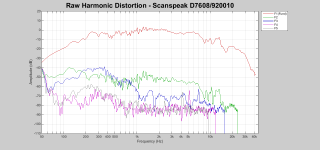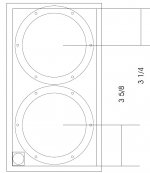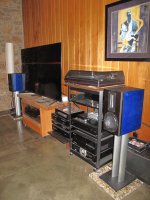Can't wait to hear your review. Can you share where you place the radiators? Its amazing given the size of your cabinet.Back to PURIFI here is a preview of the system I am a few hours of drilling and wiring away from listening to. Features 16L/0.56 cu ft enclosure each with one PTT6.5W woofer and two PTT6.5PR passive radiators. Tweeter is a Fountek Neo CD2.0 ribbon.
More details soon, for now I need to concentrate on getting my group buy guys their transducers.
For extra credit who can identify the title of the CD used for size comparison?
My impression is that the MDM55 is a very good midrange, especially for the price. But, I'm looking for an exceptionally good midrange and I'm willing to spend a fair amount on it. It seems, however, to be remarkably difficult to find a small driver with exceptional capabilities - especially HD - over the range of, say, 800 hz to 3Khz.
One would think, for example, that the Scan Speak 12M and 12MU would fit the bill, but if the data at HifiCompass is indicative, both are less than stellar in HD over that range. In fact, the SB15NBAC seems the best match to the PTT6.5.
I'll be quite happy if the PTT4.0 is as capable in the upper midrange as the PTT6.5 is below.
ETON 3-400/A8/25Mg | HiFiCompass
If you can get them?
The old vifa/peerless/scan-speak dome is still pretty good: (..though it will require a higher order high-pass crossover for higher spl use.)
Attachments
Last edited:
I use these above the purifi 6.5 , before the tweeters. They are impressive.
Do I think the etons are broken - Hell No.
Best jasdiy
Thanks for the suggestion - they do look very good. I wonder how the currently available 3-212 compares.
I'm not in a hurry, so I probably will wait to see how the PTT4.0 performs (and what it costs).
So many of you would use an:
Subwoofer first.
Then Purifie.
Then an middle.
Then an HF.
Ok, for us who have to sell two kids and lumber the woods what tweeter you recomend?
Subwoofer first.
Then Purifie.
Then an middle.
Then an HF.
Ok, for us who have to sell two kids and lumber the woods what tweeter you recomend?
So many of you would use an:
Ok, for us who have to sell two kids and lumber the woods what tweeter you recomend?
If you are going to go through all that trouble... there should be some bling to show for it...
Accuton D20-6 3/4" Diamond Dome Tweeter, 89.5dB (D20N-6-31)
The bats will be entertained with fine music with the 100khz response.
on a more reasonable note, any stout tweeter will do. Any of the beryllium ones will do, satori/SB has the most economical ones. Any of the larger domes will also do fine - from wavecor / Satori / SB / Scan / Seas. any tweeter that can crossover at 2000 should be fine.
a fan favorite that's returned is the CSS LDX25, though it's best to stay above 2k given it's 865 FS
Ribbons or AMTs might have a difficult time, unless they are of the large variety like the one Norman is using.
The PuriBliss-BeWg project is finished! Read it for your inspiration.
In Russian for a while. The English version is coming...
PuriBliss-BeWg
In Russian for a while. The English version is coming...
PuriBliss-BeWg
Can't wait to hear your review. Can you share where you place the radiators? Its amazing given the size of your cabinet.
There is a story behind the design of this speaker where the Purifi woofer and PR parameters meet the pandemic and Norman’s personality the moral being sometimes constraints are good for a design process. We’ll get into that later.
For now the answer to dewdrop’s question is the passive radiators cover essentially the entire back panel. The attached drawing shows the box rear view with PR’s cutout diameter, mounting screws locations, and frame OD. The dimensions (in inches) show where the centers of the cutouts are located off the top and bottom edges. They are pushed up a bit to allow the Speakon connector shown in the lower left hand corner to just fit.
Last night I finished the wiring harnesses. With care and luck drilling mounting holes then assembly and I hope to be listening tonight to this first Purifi based system to grace Casa Tracy.
Attachments
The PuriBliss-BeWg project is finished! Read it for your inspiration.
In Russian for a while. The English version is coming...
PuriBliss-BeWg
Bravo! HiFiCompass that must be a satisfying listen. A lot of work gone into that, very nice
The PuriBliss-BeWg project is finished! Read it for your inspiration.
In Russian for a while. The English version is coming...
PuriBliss-BeWg
Я жду с нетерпением, чтобы прочесть это!
Bravo! HiFiCompass that must be a satisfying listen. A lot of work gone into that, very nice
Google translate does an adequate job for us english speakers. Great article, a real deep dive.
The port resonance issue is encountered in a KEF Q100 by Danny Riche of GR Research in one of his upgrade videos:
YouTube
I find it interesting how the port mode shows up both audibly also in the frequency response and impedance plots. Good reminder the driver + enclosure is a closed system with the sub-systems interacting.
I ran into this issue modeling my design in UniBox. It has an option 'Include effect of port resonance'. When selected and I model the port in Purifi's application note design there are few (essentially none visible in the sim) port node resonances but air velocity is too high IMHO. So I tried my standard practice and enlarged the cross section and number of ports, even to the extreme of locating the port outside the box and using it for the post of a speaker specific stand! Thus far such fancies only exist on the pages of my sketch book and CAD. What UniBox showed is the issue addressed in HiFiCompass' work which is that as I enlarged port area (and thus length to maintain Hz tuning) nasty port mode resonances appeared. Perhaps the designer of the Purifi application note design port has a method to his madness in keeping the port diameter on the small side and addressing air velocity with flared ends.
I ran into this issue modeling my design in UniBox. It has an option 'Include effect of port resonance'. When selected and I model the port in Purifi's application note design there are few (essentially none visible in the sim) port node resonances but air velocity is too high IMHO. So I tried my standard practice and enlarged the cross section and number of ports, even to the extreme of locating the port outside the box and using it for the post of a speaker specific stand! Thus far such fancies only exist on the pages of my sketch book and CAD. What UniBox showed is the issue addressed in HiFiCompass' work which is that as I enlarged port area (and thus length to maintain Hz tuning) nasty port mode resonances appeared. Perhaps the designer of the Purifi application note design port has a method to his madness in keeping the port diameter on the small side and addressing air velocity with flared ends.
Same here. Im working on a trade off all factors considered, measurements pending
At 10:30 last night the last of the 22 screws mounting transducers in my first speaker design using Purifi transducers were tightened and I moved the speakers from shop to listening room. This is a report of the first listen to that system.
I call this design Fi16v1 (Purifi drivers in 16 liter enclosure version 1) it uses PTT6.5W04 woofers (one per speaker), PTT6.5PR passive radiators (two per speaker), and Fountek CD 2.0 ribbon tweeter. Crossover is external and should not even be considered a preliminary design. It is repurposed from my NT10 design as a stand in while drivers are measured and Fi16 crossovers (both passive and active) are designed. DSP in JRiver music player software was used to correct the 8.5 dB difference in sensitivity between woofer and tweeter.
A joke about those of us who design hi-fi loudspeakers is “the best speakers I ever heard, is the one I just finished designing”. And with hundreds of my own dollars invested and as organizer of the N. American Purifi speaker group buy the tendency to confirmation bias is undeniable. Countering that is 50 years (dang, so old) experience in the hi-fi hobby/obsession/business and if the under one hundred dollar woofers in my NT10 and omegaZed designs could beat Purifi’s that would be news worth sharing.
Recently a friend invited me over to hear a new LP copy of the jazz standard by Miles Davis ‘Kind of Blue’. My friend is one of those music lovers who upon graduating college and getting his first job as an EE bought a set of Klipsch La Scala and 30 years later they still anchor his system the utility plywood finish now with a nice patina. As the LP started I was struck by how effortless the La Scala’s 15” horn loaded woofers reproduced Paul Chambers’ double bass. Enjoying the comradeship and music I also made a mental note that I would use Davis’ ‘Kind of Blue’ as the first track played on the Fi16. Could the PTT6.5W04 woofers also make Paul Chambers so effortlessly present?
With the entire household in bed save the manic audiophile last night I made sure volume levels were low when I started ‘Kind of Blue’ on the Fi16s. Even with the handicap of operating at background levels it quickly became apparent the PTT6.5 woofers and passive radiators had that same ease and presence that made Chambers’ double bass balance in perfectly with the rest of the all-star lineup. I initially focus on this aspect of the sound because what the La Scala and Purifi woofers do that the typical 5” to 8” woofer lack is to present the bass line with what we used to call ‘presence’. In typical compact and middle size speakers the double bass is reproduced but I have to go ‘looking’ for it. When one thinks about it and listens for the bass it is there a bit attenuated and perhaps lagging just a little behind. With large format systems, and now the Purifi woofers (in a ½ cu ft box!!) the bass is just there. Purifi claim “PTT6.5W04 is a 6.5” driver that truly cracks the long-stroke code”. The ‘Kind of Blue’ test backed up that claim with listening results.
As I moved onto other tracks in addition to the exemplary bass it became apparent the claimed lower distortion was yielding really fantastic transparency throughout the bass, mid-bass, and midrange the PTT6.5 is reproducing. Again at late night background levels the fine tonal and musical textural filigreed details are more revealed. I am a huge fan of Jazz at Lincoln Center Orchestra so I had to listen to a cut from their recent “The Music of Wayne Shorter” in 24bit 96k format. Big band jazz at such low volumes was a real tease (we’ll fix that tonight) but it did reveal a striking ability to unravel the dense mix and reproduce the band’s sections as a panorama of sound.
Of course I had to try something with really deep bass. Dead Can Dance’s ‘Spiritchaser‘ album the song Indus was cued up. I am rarely accused of being succinct but the result with Indus can be described in two words. Holy crap. Oh this is going to be so much fun with Prog Rock, action movies, and large forces orchestral works.
To counter the darkness of Indus and as a goodnight prayer I ended the night’s listening with ‘In Christ Alone’ from Celtic Worship’s album Homeward, this song that begins with a bagpipe would likely clear the room given that instrument’s polarizing effect. I am in the like very much the pipes camp. Again a cut I have been listening to quite a bit lately and on the Fi16 the ragged reed sound of the pipe’s was so very transparent. As the song progresses the group modulates the intensity stronger and stronger in little steps until by the last verse and chorus it is an emotional hammer blow of spiritual devotion. In hi-fi terms it was very impressive that at those background levels the expertly modulated musical intensity was so explicitly revealed.
I will post follow up listening notes with unconstrained volume levels. This is going to be so much fun.
I call this design Fi16v1 (Purifi drivers in 16 liter enclosure version 1) it uses PTT6.5W04 woofers (one per speaker), PTT6.5PR passive radiators (two per speaker), and Fountek CD 2.0 ribbon tweeter. Crossover is external and should not even be considered a preliminary design. It is repurposed from my NT10 design as a stand in while drivers are measured and Fi16 crossovers (both passive and active) are designed. DSP in JRiver music player software was used to correct the 8.5 dB difference in sensitivity between woofer and tweeter.
A joke about those of us who design hi-fi loudspeakers is “the best speakers I ever heard, is the one I just finished designing”. And with hundreds of my own dollars invested and as organizer of the N. American Purifi speaker group buy the tendency to confirmation bias is undeniable. Countering that is 50 years (dang, so old) experience in the hi-fi hobby/obsession/business and if the under one hundred dollar woofers in my NT10 and omegaZed designs could beat Purifi’s that would be news worth sharing.
Recently a friend invited me over to hear a new LP copy of the jazz standard by Miles Davis ‘Kind of Blue’. My friend is one of those music lovers who upon graduating college and getting his first job as an EE bought a set of Klipsch La Scala and 30 years later they still anchor his system the utility plywood finish now with a nice patina. As the LP started I was struck by how effortless the La Scala’s 15” horn loaded woofers reproduced Paul Chambers’ double bass. Enjoying the comradeship and music I also made a mental note that I would use Davis’ ‘Kind of Blue’ as the first track played on the Fi16. Could the PTT6.5W04 woofers also make Paul Chambers so effortlessly present?
With the entire household in bed save the manic audiophile last night I made sure volume levels were low when I started ‘Kind of Blue’ on the Fi16s. Even with the handicap of operating at background levels it quickly became apparent the PTT6.5 woofers and passive radiators had that same ease and presence that made Chambers’ double bass balance in perfectly with the rest of the all-star lineup. I initially focus on this aspect of the sound because what the La Scala and Purifi woofers do that the typical 5” to 8” woofer lack is to present the bass line with what we used to call ‘presence’. In typical compact and middle size speakers the double bass is reproduced but I have to go ‘looking’ for it. When one thinks about it and listens for the bass it is there a bit attenuated and perhaps lagging just a little behind. With large format systems, and now the Purifi woofers (in a ½ cu ft box!!) the bass is just there. Purifi claim “PTT6.5W04 is a 6.5” driver that truly cracks the long-stroke code”. The ‘Kind of Blue’ test backed up that claim with listening results.
As I moved onto other tracks in addition to the exemplary bass it became apparent the claimed lower distortion was yielding really fantastic transparency throughout the bass, mid-bass, and midrange the PTT6.5 is reproducing. Again at late night background levels the fine tonal and musical textural filigreed details are more revealed. I am a huge fan of Jazz at Lincoln Center Orchestra so I had to listen to a cut from their recent “The Music of Wayne Shorter” in 24bit 96k format. Big band jazz at such low volumes was a real tease (we’ll fix that tonight) but it did reveal a striking ability to unravel the dense mix and reproduce the band’s sections as a panorama of sound.
Of course I had to try something with really deep bass. Dead Can Dance’s ‘Spiritchaser‘ album the song Indus was cued up. I am rarely accused of being succinct but the result with Indus can be described in two words. Holy crap. Oh this is going to be so much fun with Prog Rock, action movies, and large forces orchestral works.
To counter the darkness of Indus and as a goodnight prayer I ended the night’s listening with ‘In Christ Alone’ from Celtic Worship’s album Homeward, this song that begins with a bagpipe would likely clear the room given that instrument’s polarizing effect. I am in the like very much the pipes camp. Again a cut I have been listening to quite a bit lately and on the Fi16 the ragged reed sound of the pipe’s was so very transparent. As the song progresses the group modulates the intensity stronger and stronger in little steps until by the last verse and chorus it is an emotional hammer blow of spiritual devotion. In hi-fi terms it was very impressive that at those background levels the expertly modulated musical intensity was so explicitly revealed.
I will post follow up listening notes with unconstrained volume levels. This is going to be so much fun.
Attachments
A joke about those of us who design hi-fi loudspeakers is “the best speakers I ever heard, is the one I just finished designing”.
And with hundreds of my own dollars invested and as organizer of the N. American Purifi speaker group buy the tendency to confirmation bias is undeniable.
Sadly that is so true, often to the detriment of missing-out on other factors that might be preferred in a design that is not their own.
I found it particularly true in a few that are nearly "zealots" with respect to spouting the evils of confirmation bias and absolutely requiring double-blind tests for subjective results. Ironic! 😀
Personally I've never been that way, there are all sorts of things I dislike about each of the designs I've done: "this good, this not so much". It's been 20 years now and I've yet to fully finish (aesthetically) any design. 😱 Oh well, at least I'll re-use drivers for different projects. 🙂
This hobby is a journey, not a destination. If you think you've "arrived" you are probably "glossing-over" faults.
Last edited:
Google translate does an adequate job for us english speakers. Great article, a real deep dive.
The port resonance issue is encountered in a KEF Q100 by Danny Riche of GR Research in one of his upgrade videos:
YouTube
I find it interesting how the port mode shows up both audibly also in the frequency response and impedance plots. Good reminder the driver + enclosure is a closed system with the sub-systems interacting.
I ran into this issue modeling my design in UniBox. It has an option 'Include effect of port resonance'. When selected and I model the port in Purifi's application note design there are few (essentially none visible in the sim) port node resonances but air velocity is too high IMHO. So I tried my standard practice and enlarged the cross section and number of ports, even to the extreme of locating the port outside the box and using it for the post of a speaker specific stand! Thus far such fancies only exist on the pages of my sketch book and CAD. What UniBox showed is the issue addressed in HiFiCompass' work which is that as I enlarged port area (and thus length to maintain Hz tuning) nasty port mode resonances appeared. Perhaps the designer of the Purifi application note design port has a method to his madness in keeping the port diameter on the small side and addressing air velocity with flared ends.
The most effective implementation of port resonance suppression I've ever seen is from Technics' coaxial SB-C700. Look at the port response (credit: Stereophile):
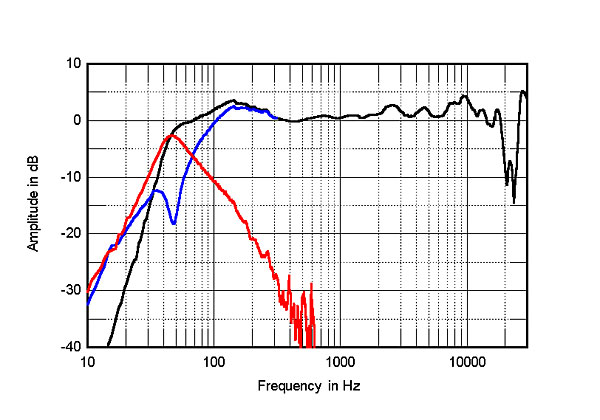
Apparently this was achieved through both a flared port, and a padded partition inside the speaker, which looks like this:
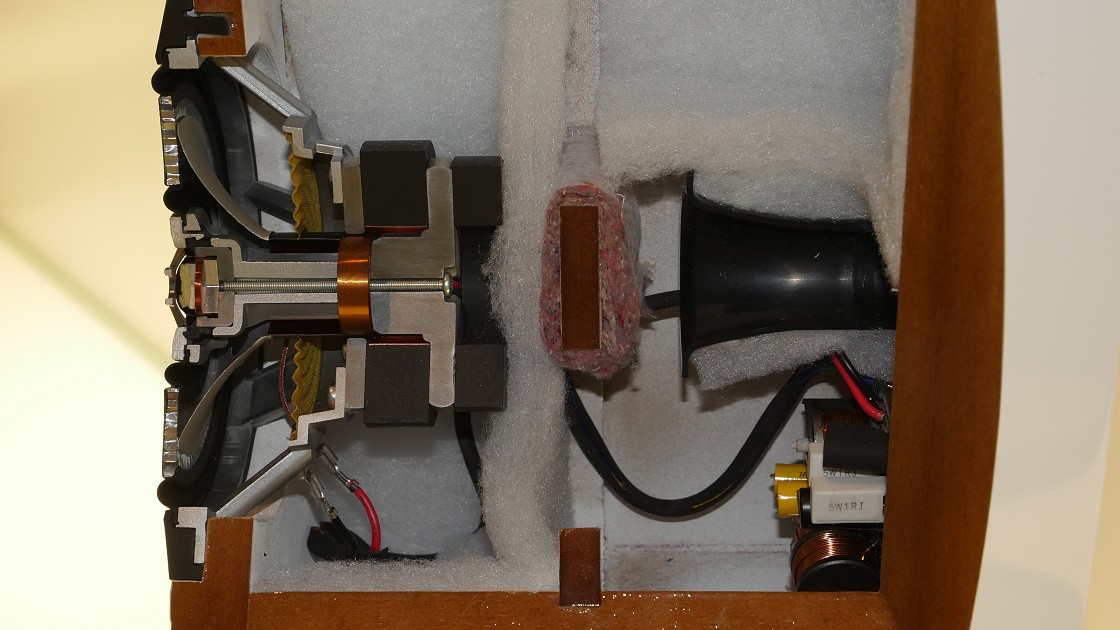


An externally hosted image should be here but it was not working when we last tested it.
What it seems like is a solid horizontal brace right across the internal opening of a flared port, wrapped thickly with insulation, as well as polyfill wrapped around the port. This might be a relevant approach for something that moves air as much as this Purifi.
I am starting to regret not purchasing the matching Purifi passive radiators. The port for a 15L box at 35Hz creates all the issues that a PR is designed to solve.
Now have to find equivalent replacement for the Purifi PR. The SB SB15SFCR-00 (also used in the Buchardt S400) looks pretty good but still not the same as the 2x Purifi.
Now have to find equivalent replacement for the Purifi PR. The SB SB15SFCR-00 (also used in the Buchardt S400) looks pretty good but still not the same as the 2x Purifi.
I can't find the specs.
- Home
- Loudspeakers
- Multi-Way
- Exploring Purifi Woofer Speaker Builds
